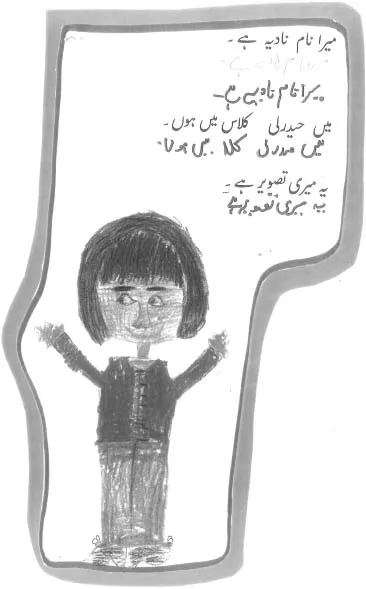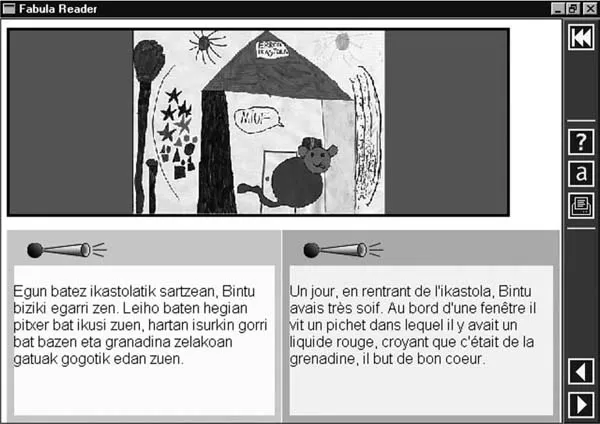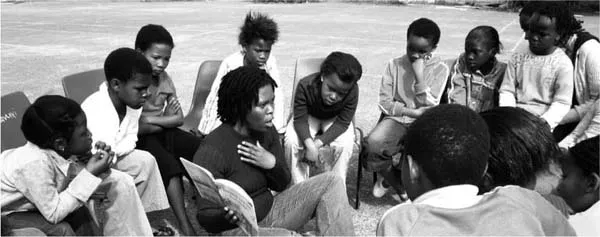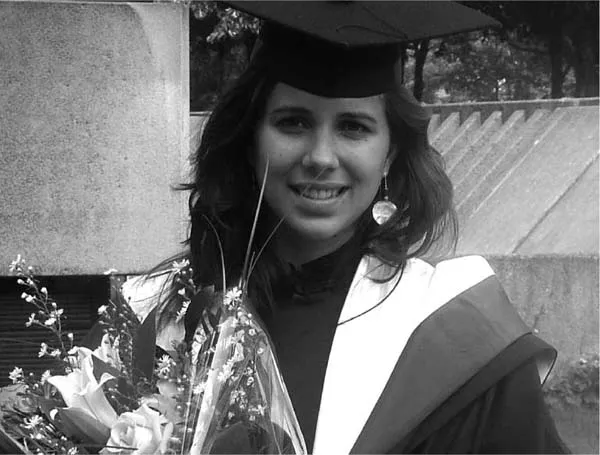![]()
1 Reading the word, reading the world
■ This brief introductory chapter describes some of the many different ways in which children learn to be literate in two or more languages and invites you to think of other examples from your own experience.
■ It draws attention to the fragmented research on literacy in multilingual settings as disparate, for instance, as rural Zimbabwe and inner city England. While recognizing that the experiences of teachers and children can be very different, it makes a case for a more integrated approach that builds on commonalities between these various settings.
■ It discusses the scope and organization of the book.
Many routes to literacy
The scope and organization of this book
Many routes to literacy
The title of this chapter comes from a book by Donaldo Macedo and Paulo Freire which makes links between literacy and politics: reading is not only about decoding the word from the page; it is also about the ways in which literacy can be used to empower and disempower people. This link is a recurring theme in the present book, too. The wordplay which underpins it is particularly appropriate in the context of the children in many different parts of the world who are learning read in more than one language. Let’s look at some examples.
Redlands Primary School serves a highly diverse population in an inner city area of a town in southern England. Over 30 different languages are spoken. Many of the children have a parent who is studying at the university or working in the hospital nearby. The largest group, though, consists of children whose parents and grandparents arrived in the UK from Pakistan in the 1960s. The language of the home is Panjabi. Many of the children, however, are learning to read and write in Urdu, the language of literature and high culture in Pakistan, in a lunchtime club taught by one of the Redlands teachers. The introduction of an Urdu word-processing program was greeted with considerable enthusiasm by parents and children who use it for writing bilingual stories and captions for classroom displays (see Figure 1.1). These activities also attracted the attention of non-Pakistani children, several of whom started to attend the Urdu club.
Figure 1.1 Part of a classroom display of self-portraits with Urdu captions
Ikastola Errobi is a small four-class school in Cambo-les-Bains in the foothills of the Pyrenees in the northern Basque country. The teachers’ salaries are paid by the French government, but the buildings and other resources are funded by a cooperative of parents, some of whom speak only French but who are anxious for their children to reclaim their Basque heritage. As part of work on narrative, children were asked to produce their own bilingual, multimedia stories in Basque – introducing the characters, setting a problem, saying what happened, providing a resolution and giving the tale a twist. They read each other’s stories, voted for the best draft – Zaunka ari zen gatua (The cat that barked) – and then worked together on improving it. Once the Basque version was complete, the story was sent to another class, where it was translated into French. The story was then read by a class of six-year-olds with less-developed Basque language skills who drew the illustrations (see Figure 1.2).
Figure 1.2 A page from the bilingual multimedia story about The cat that barked
The Vulindlela Reading Club meets in Langa, a residential area established to segregate Black Africans from other racial groups in Cape Town during the apartheid era in South Africa. The club, launched in response to a request from a community organization, welcomes up to 200 children from Grades 2 to 6 from 10 to 12 on Saturday mornings. The sessions start with circle games and the singing of the Reading Club song, Education is fun, in English and isiXhosa. The children then divide into three different age groups to listen to stories and stretch out or cuddle up with a book. The sessions usually finish with a story telling session (See Figure 1.3). English and isiXhosa are used in the Reading Club on alternate weeks.
Figure 1.3 Stories at the Vulindlela Reading Club
Play English (see Figure 1.4) in Monza, Italy, started as a playgroup for children aged three to five. The demand was such that soon there were two separate activities, a preschool day program and an after-school program. As the first Play English pupils approached elementary school age, parents, delighted with their children’s progress, exerted pressure for provision to continue. The school now covers all the elementary grades and is beginning to extend to the Middle School years. Approximately equal amounts of time are given to literacy learning in English and Italian. The academic outcomes for the children, most of whom come from Italian-speaking homes, are comparable to those of their peers attending Italian schools. But, in addition, they are able to understand, speak, read and write in English at levels far superior to children in the Italian system.
Figure 1.4 Children at Play English, Monza
The Chinese School in Reading in the south of England meets in a local primary school on Sunday mornings. It has two sections. One serves the predominantly Cantonese-speaking community that arrived in the UK in the 1950s and 1960s. The other teaches, through the medium of Mandarin or Putonghua, the official language of the People’s Republic of China. Most of the children in this section are from sojourner families who stay in the UK for three or four years for study or work; they need to maintain high levels of literacy in Chinese for their return to China. Others are the children of longer-term residents from the People’s Republic, whose parents are keen for them to either learn or maintain Chinese literacy skills. A smaller group consists of Cantonese speakers wishing to develop Mandarin in recognition of the importance of China on the world stage. A wall chart sets out the different stokes that make up Chinese characters. Great attention to detail is required: the strokes need to be written in a set order and the right proportions maintained (Figure 1.5).
Figure 1.5 A page from Li Wei’s exercise book
Alexandra d’Onofrio is a citizen of the world. Born in London to a Greek mother and Italian father, she spent the first eight years of her life in England, attending first an Italian nursery and then the Greek Embassy School before transferring to an English primary school. The family moved briefly to Greece where Alexandra attended an Italian language-medium school before settling permanently in Italy. Throughout this time, her mother nurtured reading and writing in all three of her first languages, placing more emphasis, for instance, on Italian and English when they were in Greece, and more emphasis on English and Greek in Italy. In the early stages, she read stories and used post-its to label household objects – fridge, kettle, cupboard, table – in one language on one day, and another on the next. Alexandra returned to the UK for her higher education where she graduated with a degree in Social Anthropology and Hindi (see Figure 1.6). She later traveled to Cuba and Mexico where she learned Spanish, and spent six months in Brazil working on a Theatre of the Oppressed project where she learned Portuguese.
Pakistani and Chinese children in the south of England, Basque children in the foothills of the Pyrenees, the Vulindlela Reading Club in Cape Town, children learning in Italian and English in northern Italy, Alexandra d’Onofrio – these are all examples from my personal experience of children learning to be literate in more than one language. Readers of this book will no doubt be able to add many more examples of their own.
Figure 1.6 Alexandra d’Onofrio
The scope and organization of this book
Research on literacy learning in multilingual settings has tended to be fragmentary. The catalyst for much of this work has been the large numbers of minority language-speaking children in important migrant destinations – the US, Canada, the UK and Australia. While many researchers have been concerned with the learning of English, others have focused on the opportunities for learning through other languages in ‘immersion’ and bilingual education programs. Still others have looked at the voluntary efforts of minority communities to maintain their heritage languages. Although most research is concentrated in the developed world, important exceptions include the growing numbers of studies of literacy learning in South America and Africa. There are clearly differences between these various settings, but there are also many commonalities. My aim, then, is to integrate the insights from these various strands.
It may be helpful to explain the limits at the outset. This book is not about the considerable progress made by cognitive and developmental psychologists in exploring the literacy acquisition in bilingual children. While this research is making an invaluable contribution to our understanding of the human brain, it is often unclear how these findings can be translated into classroom practice. Nor is this a practical handbook for teachers. The focus is rather on exploring theoretical and policy issues which explain current educational practice and point to possible ways forward. As such, the book will be of interest to a wide range of people – policy-makers, researchers and practitioners – concerned with language in education.
How this book is organized
The book has three main foci: multilingualism, literacy and the management of change.
Chapters 2 and 3 explore multilingualism, the first of these three foci. Chapter 2 considers the wide range of reasons why people move from one location to another, bringing with them different languages and cultures. We examine the various accommodations made when people speaking different languages come into contact – the use of lingua francas, pidgins and creoles and the shift from one language to another. We also look at nation-building and the power relations between the majority and minority languages created in the process. Multilingualism is considered from two main perspectives: the wider society and the individual. From the perspective of the individual, we discuss the intellectual, social and economic benefits associated with speaking two or more languages. From the broader societal perspective, we challenge the assumption that multilingualism leads to division and strife and look at efforts to embrace diversity in India, South Africa and the European Union.
Chapter 3 considers how different education systems accommodate linguistically diverse populations. It does this through the lens of colonization, imperialism, nationalism and globalization, four historical processes which have each shaped the fate of diverse groups of people and their languages. It considers the educational responses to speakers of nonstandard varieties, such as Black English, considered to be inferior to the standard language, and sign languages which, until recent years, were not even considered to be languages. And, finally, it examines the benefits for speakers of majority languages who elect for their children to be educated through minority languages.
The next four chapters a...






